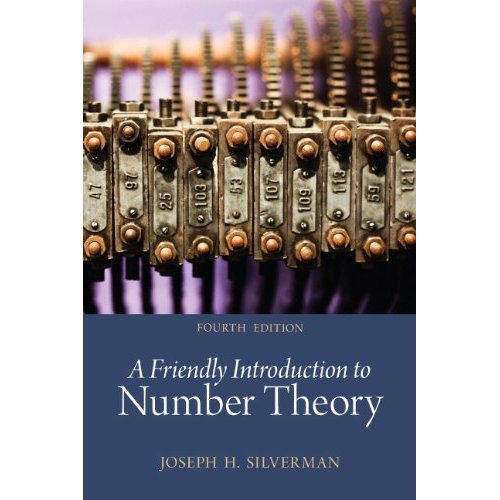A Friendly Introduction to Number Theory
Joseph H. Silverman
Fourth Edition – ISBN: 978-0-321-81619-1
– © 2012 Pearson Education, Inc.
ix + 409 + (56 online) pages –
Available from
Amazon
A Friendly Introduction to Number Theory is an introductory
undergraduate text designed to entice non-math majors into learning
some mathematics, while at the same time teaching them how to think
mathematically. The exposition is informal, with a wealth of numerical
examples that are analyzed for patterns and used to make
conjectures. Only then are theorems proved, with the emphasis on
methods of proof rather than on specific results. Starting with
nothing more than basic high school algebra, the reader is gradually
led to the point of producing their own conjectures and proofs, as
well as getting some glimpses at the frontiers of current mathematical
research.
Instructors:
To receive an evaluation copy of
A Friendly Introduction to Number Theory, send an email request to:
Evan St Cyr at Pearson.
Please include your title and full mailing address.
|
Click on the links for the following material.
Errata for the 4th edition.
(Errata for the
3rd edition is also available.)
|

|
There are a number of major changes in the fourth edition.
-
There is a new chapter on mathematical induction (Chapter 26).
-
Some material on proof by contradiction has been moved forward to
Chapter 8. It is used in the proof that a polynomial of
degree d has at most d roots modulo p. This fact
is then used in place of primitive roots as a tool to prove Euler's
quadratic residue formula in Chapter 21. (In earlier editions,
primitive roots were used for this proof.)
-
The chapters on primitive roots (Chapters 28–29) have been moved
to follow the chapters on quadratic reciprocity and sums of squares
(Chapters 20–25). The rationale for this change is the author's
experience that students find the Primitive Root Theorem to be among
the most difficult in the book. The new order allows the instructor to
cover quadratic reciprocity first, and to omit primitive roots
entirely if desired.
-
Chapter 22 now includes a proof of part of quadratic reciprocity for Jacobi
symbols, with the remaining parts included as exercises.
-
Quadratic reciprocity is now proved in full. The proofs for
(-1|p) and (2|p) remain as before in Chapter 21, and
there is a new chapter (Chapter 23) that gives Eisenstein's proof for
(p|q)(q|p). Chapter 23 is significantly
more difficult than the chapters that precede it, and it may be
omitted without affecting the subsequent chapters.
-
As an application of primitive roots, Chapter 28 discusses the construction
of Costas arrays.
-
Chapter 39 includes a proof that the period of the Fibonacci sequence
modulo p divides p–1 when p is congruent to
1 or 4 modulo 5.
-
There are many new exercises scattered throughout the text.
-
A flowchart giving chapter dependencies is included on page ix.
-
Number theory is a vast and sprawling subject, and over the years this
book has acquired many new chapters. In order to keep the length of
this edition to a reasonable size, Chapters 47–50 have been
removed from the printed version of the book. These omitted chapters
are freely available by clicking the following link:
Chapters 47–50.
The online chapters are included in the index.
To save time and eliminate typing errors,
you can use this web page to
copy and paste the numerical data for the following exercises.
Exercise 18.4
Here are two longer messages to decode if you like to use
computers.
(a) You have been sent the following message:
5272281348, 21089283929, 3117723025, 26844144908, 22890519533,
26945939925, 27395704341, 2253724391, 1481682985, 2163791130,
13583590307, 5838404872, 12165330281, 28372578777, 7536755222.
It has been encoded using
p = 187963,
q = 163841,
m = pq = 30796045883,
and
k = 48611.
Decode the message.
(b)
You intercept the following message, which you know has been encoded
using the modulus
m = 956331992007843552652604425031376690367
and exponent
k = 12398737.
Break the code and decipher the message.
821566670681253393182493050080875560504,
87074173129046399720949786958511391052,
552100909946781566365272088688468880029,
491078995197839451033115784866534122828,
172219665767314444215921020847762293421.
Exercise 18.7
Write a computer program implementing one of the factorization methods
that you studied in the previous exercise, such as
Pollard's ρ method, Pollard's p-1 method, or the
quadratic sieve. Use your program to factor the following numbers.
(a) 47386483629775753
(b) 1834729514979351371768185745442640443774091
Exercise 19.8
Program the Rabin-Miller test with multiprecision integers and use
it to investigate which of the following numbers are composite.
(a) 155196355420821961
(b) 155196355420821889
(c) 285707540662569884530199015485750433489
(d) 285707540662569884530199015485751094149
Exercise 22.7
For this exercise, use the ElGamal cryptosystem described in
Exercise 22.6.
(a)
Bob wants to use Alice's public key a = 22695 for
the prime p = 163841 and base
g = 3 to send her the message
m = 39828. He chooses to use the random number
r = 129381. Compute the encrypted message
(e1,e2) he should send to
Alice.
(b)
Suppose that Bob sends the same message to Alice, but he chooses a
different value for r. Will the encrypted message be the same?
(c)
Alice has chosen the secret key k = 278374 for the
prime p = 380803 and the base g = 2.
She receives a message (consisting of three message blocks)
(61745, 206881),
(255836, 314674),
(108147, 350768)
from Bob. Decrypt the message and convert it to letters using the
number-to-letter conversion table in Chapter 18.
-
The Prime Number Page:
Lots of interesting facts about prime numbers.
-
GIMPS:
The Great Internet Mersenne Prime Search.
-
The Number Theory Web:
A treasure trove of links to people, articles, and news related to
number theory. Aimed mainly towards professional mathematicians, but
there is something for everyone here.
No book is ever
free from error or incapable of being improved. I would be delighted
to receive comments, good or bad, and corrections from my readers. You
can send mail to me at
jhs@math.brown.edu
Return to
Top of Page.
Go to
J.H. Silverman's Home Page
.
